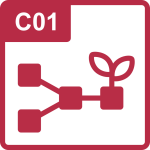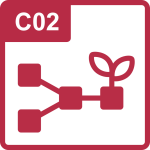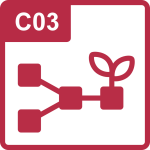The Collaborative Research Center (CRC) 1683 deals with the question of how concrete construction can become more environmentally friendly and sustainable. Instead of demolishing and recycling concrete structures, we reuse components such as walls, slabs or columns. These components are removed by sawing or water jetting, characterized, processed and then reassembled like building blocks. More than 50 scientists from Ruhr University Bochum, the Federal Institute for Materials Research and Testing (BAM), the Karlsruhe Institute of Technology (KIT) and the University of Stuttgart are working together on these concepts. We show how reused components become new load-bearing structures, how dismantling and non-destructive component testing work and how the individual steps are controlled. Automated processes make reprocessing faster and more efficient. The following sub-projects are being worked on at the Chair of Computing in Engineering:
Sub-project C01 aims to develop a holistic approach from the extraction and processing to the use of concrete elements through integrated processes and information. A digital ecosystem for circular concrete elements will provide a basis for decisions on the extent to which extracted elements from a source building can be reused for the construction of new buildings. An assessment of supply and demand will show if the design of a target building will require the additional use of new or hybrid-reconditioned elements. The ecosystem includes the interaction of digital twins of the concrete elements with the digital models of an existing source building, the intermediate depot, the production of hybrid-reconditioned elements and finally, the new target building.
Project lead: Dr.-Ing. Philipp Hagedorn, Prof. Dr.-Ing. Markus Thewes

In sub-project C02, a holistic methodology for the environmental sustainability assessment of reused concrete elements will be developed. This will enable environmental forecasts in the research of material-optimised secondary constructions in buildings as well as a multi-criteria evaluation of the respective component and the identification of combined sustainability criteria for evaluation models for classification. The aim is to utilise the potential of secondary resources while keeping an environmental sustainability in mind so that the developed construction approach, which takes advantage of reused concrete elements, in the end provides a better environmental footprint compared to traditional methods.
Project lead: Prof. Dr.-Ing. Annette Hafner, Prof. Dr.-Ing. Markus König

Sub-project C03 focuses on the dismantling of existing in-situ concrete source structures into reusable elements. The first step is to evaluate a large number of requirements for dismantling. This results in a data model with geo-metric and semantic information. For the geometric segmentation into reusable elements, efficient decomposition algorithms will be developed. In addition, spatio-temporal constraints for dismantling sequences of concrete elements will be identified, taking into account both structural safety and logistical aspects. A key outcome will be the development of a construction kit containing the identified concrete elements with high recycling potential.
Project lead: Prof. Dr.-Ing. Markus König, Prof. Dr.-Ing. Markus Thewes, Prof. Dr.-Ing. Andreas Vogel

Sub-project INF is concerned with the research data management of the CRC. The consistent storage, sharing and processing of data promotes and structures collaboration. Metadata schemas and ontologies will be used to formally describe and link data sets. Data will be made available for re-use according to the FAIR principles. A central knowledge management system will be established and continuously maintained. A crowdsourcing approach for building data will be implemented and data will be collected for the CRC demonstrators. A training and qualification programme in research data management will be developed and offered to the members of the CRC.
Project lead: Prof. Dr.-Ing. Markus König, Prof. Dr.-Ing. Andreas Vogel
